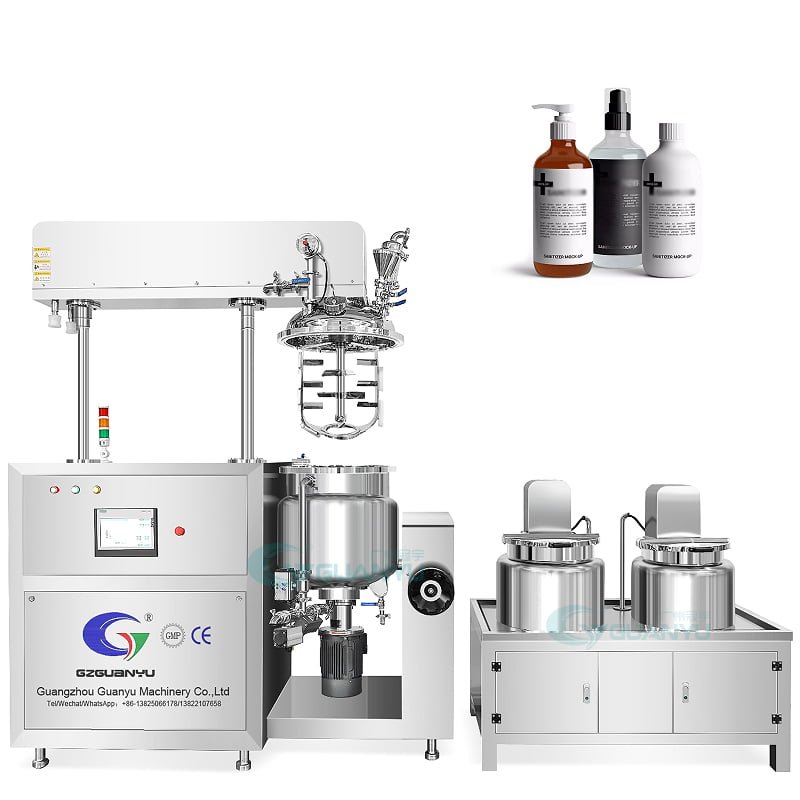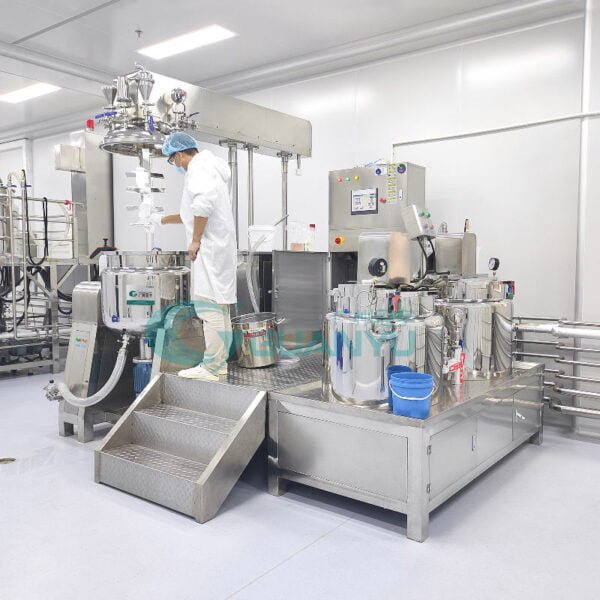آلات مستحلب الفراغ هي أجهزة صناعية أساسية مصممة لخلطها, تشتت, وتجانس المواد بكفاءة. تستخدم هذه الآلات على نطاق واسع في الصناعات مثل مستحضرات التجميل, المستحضرات الصيدلانية, إنتاج الغذاء, والتصنيع الكيميائي. باستخدام قوة القص عالية السرعة والتشغيل في ظل ظروف الفراغ, أنها تضمن الخلط المستقر للمكونات التي عادة ما تكون غير متوافقة, مثل الزيت والماء, leading to the production of stable emulsions, كريمات, or pastes. في هذه المقالة, we will explore the working principles, structure, التطبيقات, and advantages of vacuum emulsifying machines.

Working Principles of Vacuum Emulsifying Machines
The core function of a vacuum emulsifying machine is to blend ingredients into a uniform mixture through mechanical shear and homogenization, while eliminating air bubbles through the vacuum system. The process can be broken down into the following steps:
- Pre-mixing: Initially, raw materials such as liquids, مساحيق, or solids are added to the emulsifying tank. A stirrer then performs a preliminary blending to combine the ingredients.
- تجانس القص العالي: التالي, the materials are processed by a high-speed shear head. This component rotates at an extremely high speed, generating powerful shear forces that break down the materials into tiny particles or droplets, effectively dispersing immiscible ingredients like oil and water, resulting in a uniform mixture.
- Vacuum Defoaming: The vacuum system removes any air trapped during the mixing process, preventing bubbles from forming in the final product. The absence of bubbles enhances the texture, appearance, and uniformity of the mixture. بالإضافة إلى ذلك, the vacuum environment prevents oxidation, helping to maintain product quality and extending shelf life.
- Cooling and Discharging: After the mixing and homogenization steps, the material is cooled via a jacketed system surrounding the tank, ensuring the product reaches the optimal temperature for storage or packaging. The product is then discharged through a valve for further processing or packaging.
المكونات الرئيسية ل Vacuum Emulsifying Machines
Vacuum emulsifying machines consist of several vital components that work in tandem to ensure high performance:
- Emulsifying Tank: This is the main vessel where ingredients are mixed. Made from stainless steel, it often includes heating and cooling jackets to maintain precise temperature control throughout the process.
- High-Shear Head: The high-shear head is responsible for breaking down and dispersing ingredients into small particles or droplets, ensuring a uniform texture and stable mixture.
- نظام فراغ: The vacuum pump removes air from the mixing chamber, preventing the formation of air bubbles and ensuring the purity of the mixture by keeping out contaminants.
- Heating/Cooling System: To ensure the correct processing temperature, the tank has a jacketed system that can either heat or cool the material as needed.
- نظام التحكم: Modern vacuum emulsifying machines often come equipped with PLC (Programmable Logic Controller) systems that allow operators to control and monitor temperature, سرعة الخلط, and processing time through an intuitive interface.
Types of Vacuum Emulsifying Machines
There are several types of vacuum emulsifying machines available to meet different industrial needs:
Laboratory Emulsifying Machines: These are smaller machines used in research and development for testing new formulations and conducting small-scale production.




Industrial-Scale Emulsifying Machines: These large-scale machines are designed for mass production, with a higher capacity and efficiency, making them ideal for industries like cosmetics, إنتاج الغذاء, والمستحضرات الصيدلانية.



Multi-Functional Emulsifying Machines: These machines combine various functions such as mixing, قص, تجانس, التفريغ, التدفئة, and cooling, offering great flexibility to meet complex production requirements.



Applications of Vacuum Emulsifying Machines
- صناعة التجميل: Vacuum emulsifying machines are extensively used to produce skincare and haircare products such as creams, المستحضرات, شامبو, ومكيفات. These machines ensure that active ingredients are evenly dispersed, resulting in smooth, مستقر, والمنتجات عالية الجودة.
- صناعة الأدوية: في المستحضرات الصيدلانية, emulsifying machines are used to produce creams, المراهم, المواد الهلامية, and liquid medications. These machines are often built to high sanitary standards, ensuring that the production process is sterile and contamination-free.
- صناعة الأغذية: Vacuum emulsifying machines are commonly used in the production of sauces, الضمادات, منتجات الألبان, and other processed foods. They ensure that ingredients are evenly mixed and that the texture and flavor of the final product are consistent.
- الصناعة الكيميائية: In the chemical sector, these machines are used to produce paints, مواد التشحيم, المستحلبات, and cleaning agents. They improve the consistency and stability of chemical products, making them more effective and reliable.


Advantages of Vacuum Emulsifying Machines
- Efficient Homogenization: These machines use high-speed shearing to ensure that ingredients are thoroughly mixed and uniformly dispersed, resulting in small, evenly sized droplets or particles that contribute to a stable, high-quality product.
- وظيفة الفراغ: The vacuum system eliminates air bubbles, ensuring a smooth texture and preventing oxidation, which could affect the stability and shelf life of the final product.
- Automated Control: Many vacuum emulsifying machines are equipped with automated PLC control systems, allowing for precise control over variables such as temperature, سرعة, and time. This improves efficiency, reduces human error, and ensures consistent results.
- Multi-Functionality: By combining heating, تبريد, خلط, and homogenization into a single machine, vacuum emulsifying machines can handle a wide range of applications and processes, enhancing versatility and productivity.
خاتمة
Vacuum emulsifying machines play a crucial role in industries where high-quality, stable emulsions and mixtures are essential. From cosmetics to pharmaceuticals, طعام, والمواد الكيميائية, these machines enable efficient, موثوق, and high-precision production. With their advanced features such as high-shear homogenization and vacuum functionality, they are indispensable tools for manufacturers seeking to produce top-tier products.



شكرا للمشاركة. قرأت العديد من مشاركات بلوق الخاص بك, رائع, بلوق الخاص بك هو جيد جدا.
King333casino, sounds regal, يمين? It’s alright, not gonna lie. Could use a bit of a refresh, but the games are functional and get the job done. I’d say, manage your expectations, and you might have a good time. الدفع king333casino if you are curious!
CasinoPixbet? Yeah, I’ve seen that one around. The design looks pretty clean. Haven’t deposited yet, but it’s on my list. Worth a look, I reckon casinopixbet.